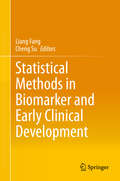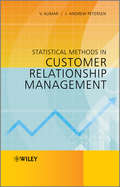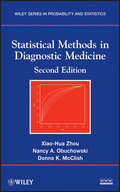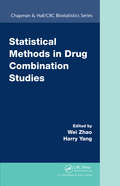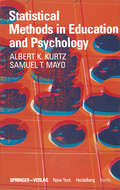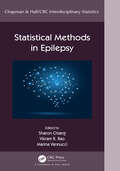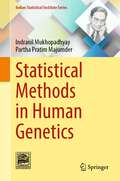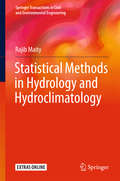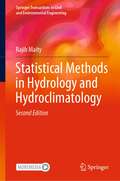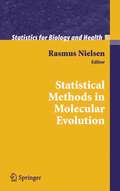- Table View
- List View
Statistical Methods in Biomarker and Early Clinical Development
by Liang Fang Cheng SuThis contributed volume offers a much-needed overview of the statistical methods in early clinical drug and biomarker development. Chapters are written by expert statisticians with extensive experience in the pharmaceutical industry and regulatory agencies. Because of this, the data presented is often accompanied by real world case studies, which will help make examples more tangible for readers. The many applications of statistics in drug development are covered in detail, making this volume a must-have reference.Biomarker development and early clinical development are the two critical areas on which the book focuses. By having the two sections of the book dedicated to each of these topics, readers will have a more complete understanding of how applying statistical methods to early drug development can help identify the right drug for the right patient at the right dose. Also presented are exciting applications of machine learning and statistical modeling, along with innovative methods and state-of-the-art advances, making this a timely and practical resource.This volume is ideal for statisticians, researchers, and professionals interested in pharmaceutical research and development. Readers should be familiar with the fundamentals of statistics and clinical trials.
Statistical Methods in Counterterrorism: Game Theory, Modeling, Syndromic Surveillance, and Biometric Authentication
by Alyson Wilson Gregory Wilson David H. OlwellWith the realization that many clues and hints preceded the September 11 terrorist attacks, statisticians became an important part of the global war on terror. This book surveys emerging research at the intersection of national security and statistical sciences. In it, a diverse group of talented researchers address such topics as Syndromic Surveillance; Modeling and Simulation; Biometric Authentication; and Game Theory. The book includes general reviews of quantitative approaches to counterterrorism, for decision makers with policy backgrounds, as well as technical treatments of statistical issues that will appeal to quantitative researchers.
Statistical Methods in Customer Relationship Management
by V. Kumar J. Andrew PetersenStatistical Methods in Customer Relationship Management focuses on the quantitative and modeling aspects of customer management strategies that lead to future firm profitability, with emphasis on developing an understanding of Customer Relationship Management (CRM) models as the guiding concept for profitable customer management. To understand and explore the functioning of CRM models, this book traces the management strategies throughout a customer’s tenure with a firm. Furthermore, the book explores in detail CRM models for customer acquisition, customer retention, customer acquisition and retention, customer churn, and customer win back. Statistical Methods in Customer Relationship Management: Provides an overview of a CRM system, introducing key concepts and metrics needed to understand and implement these models. Focuses on five CRM models: customer acquisition, customer retention, customer churn, and customer win back with supporting case studies. Explores each model in detail, from investigating the need for CRM models to looking at the future of the models. Presents models and concepts that span across the introductory, advanced, and specialist levels. Academics and practitioners involved in the area of CRM as well as instructors of applied statistics and quantitative marketing courses will benefit from this book.
Statistical Methods in Customer Relationship Management
by V. Kumar J. Andrew PetersenStatistical Methods in Customer Relationship Management focuses on the quantitative and modeling aspects of customer management strategies that lead to future firm profitability, with emphasis on developing an understanding of Customer Relationship Management (CRM) models as the guiding concept for profitable customer management. To understand and explore the functioning of CRM models, this book traces the management strategies throughout a customer’s tenure with a firm. Furthermore, the book explores in detail CRM models for customer acquisition, customer retention, customer acquisition and retention, customer churn, and customer win back. Statistical Methods in Customer Relationship Management: Provides an overview of a CRM system, introducing key concepts and metrics needed to understand and implement these models. Focuses on five CRM models: customer acquisition, customer retention, customer churn, and customer win back with supporting case studies. Explores each model in detail, from investigating the need for CRM models to looking at the future of the models. Presents models and concepts that span across the introductory, advanced, and specialist levels. Academics and practitioners involved in the area of CRM as well as instructors of applied statistics and quantitative marketing courses will benefit from this book.
Statistical Methods in Diagnostic Medicine (Wiley Series in Probability and Statistics #569)
by Xiao-Hua Zhou Donna K. McClish Nancy A. ObuchowskiAn important role of diagnostic medicine research is to estimate and compare the accuracies of diagnostic tests. This book provides a comprehensive account of statistical methods for design and analysis of diagnostic studies, including sample size calculations, estimation of the accuracy of a diagnostic test, comparison of accuracies of competing diagnostic tests, and regression analysis of diagnostic accuracy data. Discussing recently developed methods for correction of verification bias and imperfect reference bias, methods for analysis of clustered diagnostic accuracy data, and meta-analysis methods, Statistical Methods in Diagnostic Medicine explains: * Common measures of diagnostic accuracy and designs for diagnostic accuracy studies * Methods of estimation and hypothesis testing of the accuracy of diagnostic tests * Meta-analysis * Advanced analytic techniques-including methods for comparing correlated ROC curves in multi-reader studies, correcting verification bias, and correcting when an imperfect gold standard is used Thoroughly detailed with numerous applications and end-of-chapter problems as well as a related FTP site providing FORTRAN program listings, data sets, and instructional hints, Statistical Methods in Diagnostic Medicine is a valuable addition to the literature of the field, serving as a much-needed guide for both clinicians and advanced students.
Statistical Methods in Diagnostic Medicine (Wiley Series in Probability and Statistics #712)
by Xiao-Hua Zhou Nancy A. Obuchowski Donna K. McClishPraise for the First Edition " . . . the book is a valuable addition to the literature in the field, serving as a much-needed guide for both clinicians and advanced students."—Zentralblatt MATH A new edition of the cutting-edge guide to diagnostic tests in medical research In recent years, a considerable amount of research has focused on evolving methods for designing and analyzing diagnostic accuracy studies. Statistical Methods in Diagnostic Medicine, Second Edition continues to provide a comprehensive approach to the topic, guiding readers through the necessary practices for understanding these studies and generalizing the results to patient populations. Following a basic introduction to measuring test accuracy and study design, the authors successfully define various measures of diagnostic accuracy, describe strategies for designing diagnostic accuracy studies, and present key statistical methods for estimating and comparing test accuracy. Topics new to the Second Edition include: Methods for tests designed to detect and locate lesions Recommendations for covariate-adjustment Methods for estimating and comparing predictive values and sample size calculations Correcting techniques for verification and imperfect standard biases Sample size calculation for multiple reader studies when pilot data are available Updated meta-analysis methods, now incorporating random effects Three case studies thoroughly showcase some of the questions and statistical issues that arise in diagnostic medicine, with all associated data provided in detailed appendices. A related web site features Fortran, SAS®, and R software packages so that readers can conduct their own analyses. Statistical Methods in Diagnostic Medicine, Second Edition is an excellent supplement for biostatistics courses at the graduate level. It also serves as a valuable reference for clinicians and researchers working in the fields of medicine, epidemiology, and biostatistics.
Statistical Methods in Diagnostic Medicine (Wiley Series in Probability and Statistics #712)
by Xiao-Hua Zhou Nancy A. Obuchowski Donna K. McClishPraise for the First Edition " . . . the book is a valuable addition to the literature in the field, serving as a much-needed guide for both clinicians and advanced students."—Zentralblatt MATH A new edition of the cutting-edge guide to diagnostic tests in medical research In recent years, a considerable amount of research has focused on evolving methods for designing and analyzing diagnostic accuracy studies. Statistical Methods in Diagnostic Medicine, Second Edition continues to provide a comprehensive approach to the topic, guiding readers through the necessary practices for understanding these studies and generalizing the results to patient populations. Following a basic introduction to measuring test accuracy and study design, the authors successfully define various measures of diagnostic accuracy, describe strategies for designing diagnostic accuracy studies, and present key statistical methods for estimating and comparing test accuracy. Topics new to the Second Edition include: Methods for tests designed to detect and locate lesions Recommendations for covariate-adjustment Methods for estimating and comparing predictive values and sample size calculations Correcting techniques for verification and imperfect standard biases Sample size calculation for multiple reader studies when pilot data are available Updated meta-analysis methods, now incorporating random effects Three case studies thoroughly showcase some of the questions and statistical issues that arise in diagnostic medicine, with all associated data provided in detailed appendices. A related web site features Fortran, SAS®, and R software packages so that readers can conduct their own analyses. Statistical Methods in Diagnostic Medicine, Second Edition is an excellent supplement for biostatistics courses at the graduate level. It also serves as a valuable reference for clinicians and researchers working in the fields of medicine, epidemiology, and biostatistics.
Statistical Methods in Drug Combination Studies
by Wei Zhao Harry YangThe growing interest in using combination drugs to treat various complex diseases has spawned the development of many novel statistical methodologies. The theoretical development, coupled with advances in statistical computing, makes it possible to apply these emerging statistical methods in in vitro and in vivo drug combination assessments. Howeve
Statistical Methods in e-Commerce Research (Statistics in Practice #33)
by Wolfgang Jank Galit ShmueliThis groundbreaking book introduces the application of statistical methodologies to e-Commerce data With the expanding presence of technology in today's economic market, the use of the Internet for buying, selling, and investing is growing more popular and public in nature. Statistical Methods in e-Commerce Research is the first book of its kind to focus on the statistical models and methods that are essential in order to analyze information from electronic-commerce (e-Commerce) transactions, identify the challenges that arise with new e-Commerce data structures, and discover new knowledge about consumer activity. This collection gathers over thirty researchers and practitioners from the fields of statistics, computer science, information systems, and marketing to discuss the growing use of statistical methods in e-Commerce research. From privacy protection to economic impact, the book first identifies the many obstacles that are encountered while collecting, cleaning, exploring, and analyzing e-Commerce data. Solutions to these problems are then suggested using established and newly developed statistical and data mining methods. Finally, a look into the future of this evolving area of study is provided through an in-depth discussion of the emerging methods for conducting e-Commerce research. Statistical Methods in e-Commerce Research successfully bridges the gap between statistics and e-Commerce, introducing a statistical approach to solving challenges that arise in the context of online transactions, while also introducing a wide range of e-Commerce applications and problems where novel statistical methodology is warranted. It is an ideal text for courses on e-Commerce at the upper-undergraduate and graduate levels and also serves as a valuable reference for researchers and analysts across a wide array of subject areas, including economics, marketing, and information systems who would like to gain a deeper understanding of the use of statistics in their work.
Statistical Methods in Education and Psychology
by A.K. Kurtz S.T. MayoThis book is intended for use in the elementary statistics course in Educa tion or in Psychology. While it is primarily designed for use in the first semester of a two-semester course, it may also be used in a one-semester course. There are not five or ten competing texts; the number is much closer to fifty or a hundred. Why, then, should we write still another one? A new statistics text for use in Education and Psychology is, to some slight extent, comparable to a new translation or edition of the Bible. Most of it has been said before-but this time with a difference. The present writers realize that elementary statistics students know very little about the subject-even the meaning of I is all Greek to them. This text covers the basic course in depth, with examples using real data from the real world. It, of course, contains the usual reference tables and several new ones; it gives the appropriate formulas every time; and it accurately depicts all graphs. It is so comprehensive that if instructors can't find their own special areas of interest covered, then those interests probably don't belong in a basic text.
Statistical Methods in Epilepsy (Chapman & Hall/CRC Interdisciplinary Statistics)
by Sharon Chiang Vikram R. Rao Marina VannucciEpilepsy research promises new treatments and insights into brain function, but statistics and machine learning are paramount for extracting meaning from data and enabling discovery. Statistical Methods in Epilepsy provides a comprehensive introduction to statistical methods used in epilepsy research. Written in a clear, accessible style by leading authorities, this textbook demystifies introductory and advanced statistical methods, providing a practical roadmap that will be invaluable for learners and experts alike.Topics include a primer on version control and coding, pre-processing of imaging and electrophysiological data, hypothesis testing, generalized linear models, survival analysis, network analysis, time-series analysis, spectral analysis, spatial statistics, unsupervised and supervised learning, natural language processing, prospective trial design, pharmacokinetic and pharmacodynamic modeling, and randomized clinical trials.Features: Provides a comprehensive introduction to statistical methods employed in epilepsy research Divided into four parts: Basic Processing Methods for Data Analysis; Statistical Models for Epilepsy Data Types; Machine Learning Methods; and Clinical Studies Covers methodological and practical aspects, as well as worked-out examples with R and Python code provided in the online supplement Includes contributions by experts in the field The handbook targets clinicians, graduate students, medical students, and researchers who seek to conduct quantitative epilepsy research. The topics covered extend broadly to quantitative research in other neurological specialties and provide a valuable reference for the field of neurology.
Statistical Methods in Epilepsy (Chapman & Hall/CRC Interdisciplinary Statistics)
Epilepsy research promises new treatments and insights into brain function, but statistics and machine learning are paramount for extracting meaning from data and enabling discovery. Statistical Methods in Epilepsy provides a comprehensive introduction to statistical methods used in epilepsy research. Written in a clear, accessible style by leading authorities, this textbook demystifies introductory and advanced statistical methods, providing a practical roadmap that will be invaluable for learners and experts alike.Topics include a primer on version control and coding, pre-processing of imaging and electrophysiological data, hypothesis testing, generalized linear models, survival analysis, network analysis, time-series analysis, spectral analysis, spatial statistics, unsupervised and supervised learning, natural language processing, prospective trial design, pharmacokinetic and pharmacodynamic modeling, and randomized clinical trials.Features: Provides a comprehensive introduction to statistical methods employed in epilepsy research Divided into four parts: Basic Processing Methods for Data Analysis; Statistical Models for Epilepsy Data Types; Machine Learning Methods; and Clinical Studies Covers methodological and practical aspects, as well as worked-out examples with R and Python code provided in the online supplement Includes contributions by experts in the field The handbook targets clinicians, graduate students, medical students, and researchers who seek to conduct quantitative epilepsy research. The topics covered extend broadly to quantitative research in other neurological specialties and provide a valuable reference for the field of neurology.
Statistical Methods in Health Disparity Research (Chapman & Hall/CRC Biostatistics Series)
by J. Sunil RaoA health disparity refers to a higher burden of illness, injury, disability, or mortality experienced by one group relative to others attributable to multiple factors including socioeconomic status, environmental factors, insufficient access to health care, individual risk factors, and behaviors and inequalities in education. These disparities may be due to many factors including age, income, and race. Statistical Methods in Health Disparity Research will focus on their estimation, ranging from classical approaches including the quantification of a disparity, to more formal modeling, to modern approaches involving more flexible computational approaches. Features:• Presents an overview of methods and applications of health disparity estimation• First book to synthesize research in this field in a unified statistical framework• Covers classical approaches, and builds to more modern computational techniques• Includes many worked examples and case studies using real data• Discusses available software for estimation The book is designed primarily for researchers and graduate students in biostatistics, data science, and computer science. It will also be useful to many quantitative modelers in genetics, biology, sociology, and epidemiology.
Statistical Methods in Health Disparity Research (Chapman & Hall/CRC Biostatistics Series)
by J. Sunil RaoA health disparity refers to a higher burden of illness, injury, disability, or mortality experienced by one group relative to others attributable to multiple factors including socioeconomic status, environmental factors, insufficient access to health care, individual risk factors, and behaviors and inequalities in education. These disparities may be due to many factors including age, income, and race. Statistical Methods in Health Disparity Research will focus on their estimation, ranging from classical approaches including the quantification of a disparity, to more formal modeling, to modern approaches involving more flexible computational approaches. Features:• Presents an overview of methods and applications of health disparity estimation• First book to synthesize research in this field in a unified statistical framework• Covers classical approaches, and builds to more modern computational techniques• Includes many worked examples and case studies using real data• Discusses available software for estimation The book is designed primarily for researchers and graduate students in biostatistics, data science, and computer science. It will also be useful to many quantitative modelers in genetics, biology, sociology, and epidemiology.
Statistical Methods in Healthcare
by Frederick Faltin Ron S. Kenett Fabrizio RuggeriIn recent years the number of innovative medicinal products and devices submitted and approved by regulatory bodies has declined dramatically. The medical product development process is no longer able to keep pace with increasing technologies, science and innovations and the goal is to develop new scientific and technical tools and to make product development processes more efficient and effective. Statistical Methods in Healthcare focuses on the application of statistical methodologies to evaluate promising alternatives and to optimize the performance and demonstrate the effectiveness of those that warrant pursuit is critical to success. Statistical methods used in planning, delivering and monitoring health care, as well as selected statistical aspects of the development and/or production of pharmaceuticals and medical devices are also addressed. With a focus on finding solutions to these challenges, this book: Provides a comprehensive, in-depth treatment of statistical methods in healthcare, along with a reference source for practitioners and specialists in health care and drug development. Offers a broad coverage of standards and established methods through leading edge techniques. Uses an integrated, case-study based approach, with focus on applications. Looks at the use of analytical and monitoring schemes to evaluate therapeutic performance. Features the application of modern quality management systems to clinical practice, and to pharmaceutical development and production processes. Addresses the use of modern Statistical methods such as Adaptive Design, Seamless Design, Data Mining, Bayesian networks and Bootstrapping that can be applied to support the challenging new vision. Practitioners in healthcare-related professions, ranging from clinical trials to care delivery to medical device design, as well as statistical researchers in the field, will benefit from this book.
Statistical Methods in Healthcare
by Frederick W. Faltin Ron S. Kenett Fabrizio RuggeriIn recent years the number of innovative medicinal products and devices submitted and approved by regulatory bodies has declined dramatically. The medical product development process is no longer able to keep pace with increasing technologies, science and innovations and the goal is to develop new scientific and technical tools and to make product development processes more efficient and effective. Statistical Methods in Healthcare focuses on the application of statistical methodologies to evaluate promising alternatives and to optimize the performance and demonstrate the effectiveness of those that warrant pursuit is critical to success. Statistical methods used in planning, delivering and monitoring health care, as well as selected statistical aspects of the development and/or production of pharmaceuticals and medical devices are also addressed. With a focus on finding solutions to these challenges, this book: Provides a comprehensive, in-depth treatment of statistical methods in healthcare, along with a reference source for practitioners and specialists in health care and drug development. Offers a broad coverage of standards and established methods through leading edge techniques. Uses an integrated, case-study based approach, with focus on applications. Looks at the use of analytical and monitoring schemes to evaluate therapeutic performance. Features the application of modern quality management systems to clinical practice, and to pharmaceutical development and production processes. Addresses the use of modern Statistical methods such as Adaptive Design, Seamless Design, Data Mining, Bayesian networks and Bootstrapping that can be applied to support the challenging new vision. Practitioners in healthcare-related professions, ranging from clinical trials to care delivery to medical device design, as well as statistical researchers in the field, will benefit from this book.
Statistical Methods in Human Genetics (Indian Statistical Institute Series)
by Indranil Mukhopadhyay Partha Pratim MajumderThis book provides an overview of statistical concepts and basic methodology for the study of genetics of human traits and diseases. It attempts to provide a step-by-step description of problem identification, study design, methodology of data collection, data exploration, data summarization and visualization, and more advanced analytical methods for inferring genetic underpinnings of human phenotypes. The book provides codes in R programming language for implementation of most of the statistical methods described, which will enable practitioners to perform analysis of data on their own, without having to mold the data to fit the requirements of commercial statistical packages. Useful to anyone engaged in studies to understand and manage good health, the book is a useful guide for sustainable development of humankind. Primarily intended for practicing biologists especially those who carry out quantitative biological research, in particular, human geneticists, the book is also helpful in classroom teaching.
Statistical Methods in Hydrology and Hydroclimatology (Springer Transactions in Civil and Environmental Engineering)
by Rajib MaityThis book focuses on the application of statistical methods in the field of hydrology and hydroclimatology. Among the latest theories being used in these fields, the book introduces the theory of copulas and its applications in this context. The purpose is to develop an understanding and illustrate the usefulness of the statistical techniques with detailed theory and numerous worked out examples. Apart from this, MATLAB-based codes and solutions of some worked out examples are also provided to assist the readers to handle real life data. This book presents a comprehensive knowledge of statistical techniques combining the basics of probability and the current advances in stochastic hydrology. Besides serving as a textbook for graduate courses on stochastic modeling in hydrology and related disciplines, the book offers valuable resources for researchers and professionals involved in the field of hydrology and climatology.
Statistical Methods in Hydrology and Hydroclimatology (Springer Transactions in Civil and Environmental Engineering)
by Rajib MaityThis second edition focuses on the application of statistical methods in the field of hydrology and hydroclimatology. Among the latest theories being used in these fields, the book introduces the theory of copulas and its applications in this context. The purpose is to develop an understanding and illustrate the usefulness of the statistical techniques with detailed theory and numerous worked out examples. Apart from this, sample scripts based on MATLAB, Python and R for some examples are also provided to assist the readers to handle real life data. Besides serving as a textbook for graduate courses on stochastic modeling in hydrology and related disciplines, the book offers a valuable resource for researchers and professionals involved in the field of hydrology and climatology.
Statistical Methods in Medical Research
by Peter Armitage Geoffrey Berry J. N. MatthewsThe explanation and implementation of statistical methods for the medical researcher or statistician remains an integral part of modern medical research. This book explains the use of experimental and analytical biostatistics systems. Its accessible style allows it to be used by the non-mathematician as a fundamental component of successful research. Since the third edition, there have been many developments in statistical techniques. The fourth edition provides the medical statistician with an accessible guide to these techniques and to reflect the extent of their usage in medical research. The new edition takes a much more comprehensive approach to its subject. There has been a radical reorganization of the text to improve the continuity and cohesion of the presentation and to extend the scope by covering many new ideas now being introduced into the analysis of medical research data. The authors have tried to maintain the modest level of mathematical exposition that characterized the earlier editions, essentially confining the mathematics to the statement of algebraic formulae rather than pursuing mathematical proofs. Received the Highly Commended Certificate in the Public Health Category of the 2002 BMA Books Competition.
Statistical Methods in Medical Research
by Charan Singh RayatThis book covers all aspects of statistical methods in detail with applications. It presents solutions to the needs of post-graduate medical students, doctors and basic medical scientists for statistical evaluation of data. In present era, dependency on softwares for statistical analysis is eroding the basic understanding of the statistical methods and their applications. As a result, there are very few basic medical scientists capable of analyzing their research data due to lack of knowledge and ability. This book has been written in systematic way supported by figures and tables for basic understanding of various terms, definitions, formulae and applications of statistical methods with solved examples and graphic presentation of data to create interest in this mathematical science.
Statistical Methods in Molecular Biology (Methods in Molecular Biology #620)
by Heejung Bang, Xi Kathy Zhou, Heather L. Epps and Madhu MazumdarStatistical Methods in Molecular Evolution (Statistics for Biology and Health)
by Rasmus NielsenIn the field of molecular evolution, inferences about past evolutionary events are made using molecular data from currently living species. With the availability of genomic data from multiple related species, molecular evolution has become one of the most active and fastest growing fields of study in genomics and bioinformatics. Most studies in molecular evolution rely heavily on statistical procedures based on stochastic process modelling and advanced computational methods including high-dimensional numerical optimization and Markov Chain Monte Carlo. This book provides an overview of the statistical theory and methods used in studies of molecular evolution. It includes an introductory section suitable for readers that are new to the field, a section discussing practical methods for data analysis, and more specialized sections discussing specific models and addressing statistical issues relating to estimation and model choice. The chapters are written by the leaders of field and they will take the reader from basic introductory material to the state-of-the-art statistical methods. This book is suitable for statisticians seeking to learn more about applications in molecular evolution and molecular evolutionary biologists with an interest in learning more about the theory behind the statistical methods applied in the field. The chapters of the book assume no advanced mathematical skills beyond basic calculus, although familiarity with basic probability theory will help the reader. Most relevant statistical concepts are introduced in the book in the context of their application in molecular evolution, and the book should be accessible for most biology graduate students with an interest in quantitative methods and theory. Rasmus Nielsen received his Ph.D. form the University of California at Berkeley in 1998 and after a postdoc at Harvard University, he assumed a faculty position in Statistical Genomics at Cornell University. He is currently an Ole Rømer Fellow at the University of Copenhagen and holds a Sloan Research Fellowship. His is an associate editor of the Journal of Molecular Evolution and has published more than fifty original papers in peer-reviewed journals on the topic of this book. From the reviews: "...Overall this is a very useful book in an area of increasing importance." Journal of the Royal Statistical Society "I find Statistical Methods in Molecular Evolution very interesting and useful. It delves into problems that were considered very difficult just several years ago...the book is likely to stimulate the interest of statisticians that are unaware of this exciting field of applications. It is my hope that it will also help the 'wet lab' molecular evolutionist to better understand mathematical and statistical methods." Marek Kimmel for the Journal of the American Statistical Association, September 2006 "Who should read this book? We suggest that anyone who deals with molecular data (who does not?) and anyone who asks evolutionary questions (who should not?) ought to consult the relevant chapters in this book." Dan Graur and Dror Berel for Biometrics, September 2006 "Coalescence theory facilitates the merger of population genetics theory with phylogenetic approaches, but still, there are mostly two camps: phylogeneticists and population geneticists. Only a few people are moving freely between them. Rasmus Nielsen is certainly one of these researchers, and his work so far has merged many population genetic and phylogenetic aspects of biological research under the umbrella of molecular evolution. Although Nielsen did not contribute a chapter to his book, his work permeates all its chapters. This book gives an overview of his interests and current achievements in molecular evolution. In short, this book should be on your bookshelf." Peter Beerli for Evolution, 60(2), 2006
Statistical Methods in Psychiatry and Related Fields: Longitudinal, Clustered, and Other Repeated Measures Data (Chapman & Hall/CRC Interdisciplinary Statistics)
by Ralitza GueorguievaData collected in psychiatry and related fields are complex because outcomes are rarely directly observed, there are multiple correlated repeated measures within individuals, there is natural heterogeneity in treatment responses and in other characteristics in the populations. Simple statistical methods do not work well with such data. More advanced statistical methods capture the data complexity better, but are difficult to apply appropriately and correctly by investigators who do not have advanced training in statistics. This book presents, at a non-technical level, several approaches for the analysis of correlated data: mixed models for continuous and categorical outcomes, nonparametric methods for repeated measures and growth mixture models for heterogeneous trajectories over time. Separate chapters are devoted to techniques for multiple comparison correction, analysis in the presence of missing data, adjustment for covariates, assessment of mediator and moderator effects, study design and sample size considerations. The focus is on the assumptions of each method, applicability and interpretation rather than on technical details. Features Provides an overview of intermediate to advanced statistical methods applied to psychiatry. Takes a non-technical approach with mathematical details kept to a minimum. Includes lots of detailed examples from published studies in psychiatry and related fields. Software programs, data sets and output are available on a supplementary website. The intended audience are applied researchers with minimal knowledge of statistics, although the book could also benefit collaborating statisticians. The book, together with the online materials, is a valuable resource aimed at promoting the use of appropriate statistical methods for the analysis of repeated measures data. Ralitza Gueorguieva is a Senior Research Scientist at the Department of Biostatistics, Yale School of Public Health. She has more than 20 years experience in statistical methodology development and collaborations with psychiatrists and other researchers, and is the author of over 130 peer-reviewed publications.
Statistical Methods in Psychiatry and Related Fields: Longitudinal, Clustered, and Other Repeated Measures Data (Chapman & Hall/CRC Interdisciplinary Statistics)
by Ralitza GueorguievaData collected in psychiatry and related fields are complex because outcomes are rarely directly observed, there are multiple correlated repeated measures within individuals, there is natural heterogeneity in treatment responses and in other characteristics in the populations. Simple statistical methods do not work well with such data. More advanced statistical methods capture the data complexity better, but are difficult to apply appropriately and correctly by investigators who do not have advanced training in statistics. This book presents, at a non-technical level, several approaches for the analysis of correlated data: mixed models for continuous and categorical outcomes, nonparametric methods for repeated measures and growth mixture models for heterogeneous trajectories over time. Separate chapters are devoted to techniques for multiple comparison correction, analysis in the presence of missing data, adjustment for covariates, assessment of mediator and moderator effects, study design and sample size considerations. The focus is on the assumptions of each method, applicability and interpretation rather than on technical details. Features Provides an overview of intermediate to advanced statistical methods applied to psychiatry. Takes a non-technical approach with mathematical details kept to a minimum. Includes lots of detailed examples from published studies in psychiatry and related fields. Software programs, data sets and output are available on a supplementary website. The intended audience are applied researchers with minimal knowledge of statistics, although the book could also benefit collaborating statisticians. The book, together with the online materials, is a valuable resource aimed at promoting the use of appropriate statistical methods for the analysis of repeated measures data. Ralitza Gueorguieva is a Senior Research Scientist at the Department of Biostatistics, Yale School of Public Health. She has more than 20 years experience in statistical methodology development and collaborations with psychiatrists and other researchers, and is the author of over 130 peer-reviewed publications.
